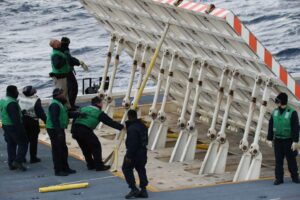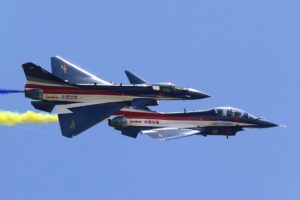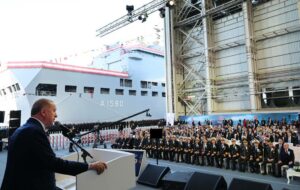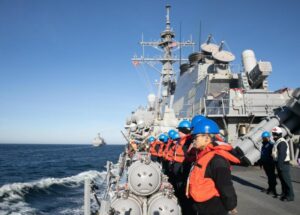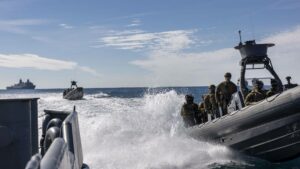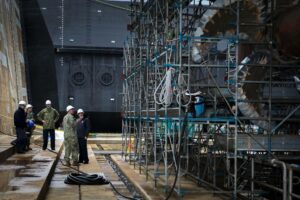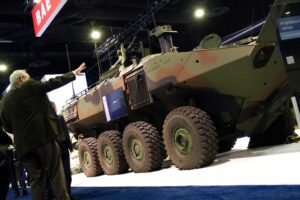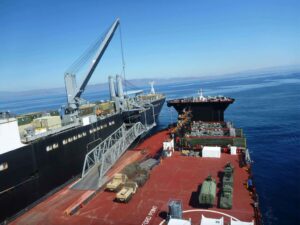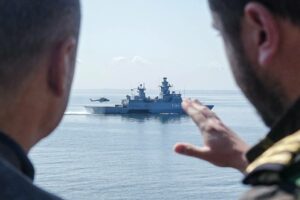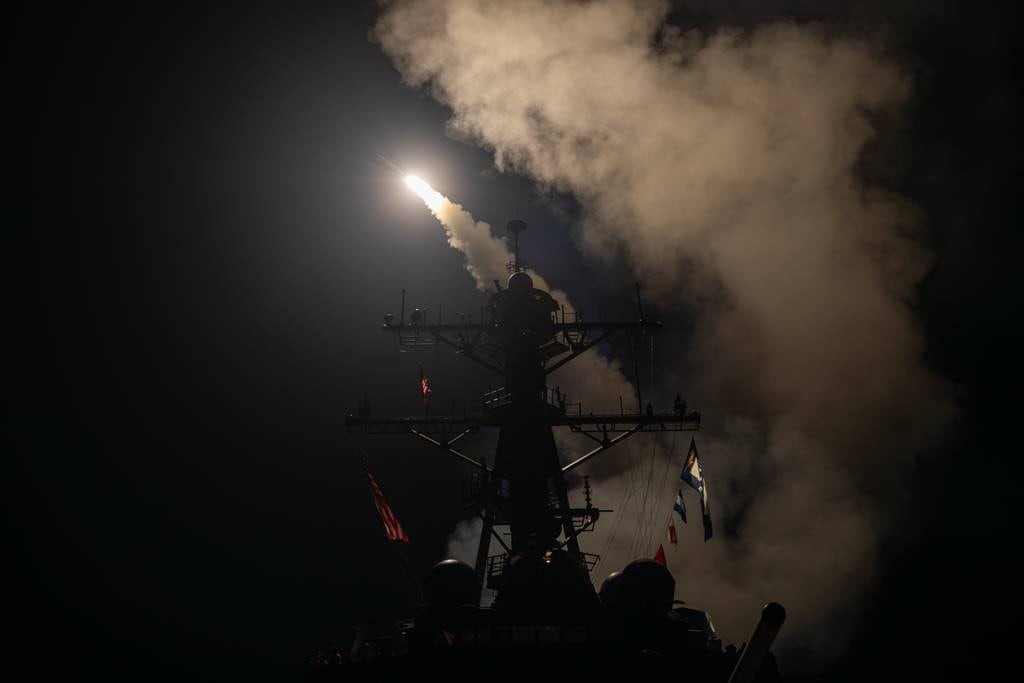
Thirteen years ago, the current head of the Navy’s surface fleet was captaining the destroyer Carney.
Even in 2010, airborne drones were a threat for which his ship had tactics and munitions at the ready, Vice Adm. Brendan McLane, now the head of Naval Surface Forces, told reporters earlier this month.
“We had a specific tactic to go after it, with a specific munition that we could shoot out our gun,” McLane said.
Fast forward to the present day and McLane has watched his former warship Carney, along with fellow destroyers Gravely, Laboon, Mason and Thomas Hudner, shoot down dozens of attack drones and missiles in the Red Sea in recent months.
Iran-backed Houthi rebels have launched attacks at commercial vessels transiting the vital economic waterway, and sometimes at Navy warships themselves. The attacks have come on a regular basis since the Oct. 7 attack on Israel by Hamas, and Israel’s subsequent operations to clear the militant group from the Gaza Strip.
The Carney and other warships have been at the spear’s tip for intercepting these attacks, shooting down scores of Houthi air attack drones in the process.
And while it remains to be seen whether last week’s U.S.-led bombing of Houthi sites in Yemen will cause the rebels to meaningfully relent, current Navy leaders and analysts agree: The volume of intercepts in the Red Sea is without modern precedent for the Navy, and the surface fleet is quickly learning from the encounters.
Those lessons are also raising questions about which warship weapons are right for such a job. While McLane declined to get into the specifics of how the Red Sea fight is impacting tactics and training during a recent interview, citing classification levels, he said the surface fleet is tracking developments “very closely.”
“We have our warfare tactics instructors involved in analyzing the data that we’re getting from the tapes on the Carney and the other ships,” he said. “And we’re looking very closely at profiles and what we have to do when it comes to radar tuning. And what we have to do when it comes to setting up our weapons system on the ship to make sure that we have … maximum defensive capability at all times.”
Those instructors are also helping to analyze data and provide updated tactics, techniques and procedures, Rear Adm. Joseph Cahill, the head of Naval Surface Force Atlantic, told reporters this month.
While destroyers have taken part in a variety of missions over the years to keep commerce flowing in the Middle East, the months-long effort to shoot down Houthi missiles and drones is new, and something the Navy hasn’t done regularly since gunfire support missions during the Vietnam War, according to Jan van Tol, a retired forward-deployed warship captain and senior fellow at the Center for Strategic and Budgetary Assessments.
The surface fleet finds itself steaming through uncharted waters in the Red Sea, when it comes to the types of munitions they are intercepting and the sustained nature of the threat.
“This is a mix we haven’t seen before, and it does represent a new wrinkle,” retired Vice. Adm. Robert Murrett, a former vice director of intelligence for the Joint Chiefs of Staff who now leads the Institute for Security Policy and Law at Syracuse University.
According to McLane, the captain of the Carney, Cmdr. Jeremy Robertson, has reported that while his crew has been working hard, the urgency of the mission seems to have supercharged the deck plates.
“[Robertson] told me that, two days after their first engagement, he had 15 reenlistment contracts on his desk,” McLane said. “I think this has something to do with the investment that we’ve made in [weapons tactics instructors], and the investment that we’ve made in developing a warfighting culture.
“Our sailors are incredibly energized by being able to operate their weapons systems in the way that they are intended and seeing success in doing that.”
Pick your poison
The Navy’s Red Sea engagements have often pitted relatively cheap, Iran-made attack drones against a Navy destroyer’s SM-2 missiles, which cost roughly $2.4 million each but allow a ship to take out a threat from a greater distance compared to other onboard weapons systems.
To date, the SM-2 munition is the only one used in the Red Sea that the sea service has officially confirmed.
Relying on a pricey asset to eliminate cheap threats raises questions about the sustainability and efficiency of the tactic, multiple analysts told Navy Times.
Navy leaders have indicated that they feel good about the surface fleet’s munitions stockpile.
“Right now, we’re stable in our inventory,” Rear Adm. Fred Pyle, head of the Surface Warfare Division for the Office of the Chief of Naval Operations, told reporters this month. “But it’s something we are very focused on and we continue to work on it.”
Still, some analysts argue that shooting Houthi drones out of the sky with SM-2s might not be an ideal solution.
“Today’s operations will stress the sustainability of the U.S. surface fleet, which relies on relatively expensive weapons for self-defense,” Bryan Clark, a retired submariner and current senior fellow at the Hudson Institute, said in an email to Navy Times.
Not relying so heavily on the SM-2 could allow commanders to “become more comfortable” with the idea of letting drones get in closer proximity to where they can be taken out with less expensive assets, said James Holmes, a former surface warfare officer and director of maritime strategy at the Naval War College.
But not relying on SM-2s to take out Houthi threats and engaging attack drones with different systems at a shorter range involves greater risk to a Navy warship and its crew, Holmes warned.
“Anything we can do to bring about a soft kill, whether through the new electronic-warfare upgrades to our destroyers, or through directed energy, is certainly worth exploring as we try to keep costs down and manage weapons inventories,” he said.
The surface fleet could create new concepts to defend against such attacks that don’t require firing their SM-2s, a combination of defensive air drones, electronic warfare and other assets, he added.
While the Navy has been “pretty cagey with operational details for obvious reasons,” Holmes noted that these expensive engagements are “expending a finite inventory of surface-to-air missiles.”
“[I have] no idea what specific doctrine our ships are using in the Red Sea, but you generally train to use multiple missiles per engagement,” Holmes said. “If it’s an SM-2 engagement … the latest variant of the SM-2 seems to run about $2.4 million per round, so you’re talking just under $5 million to bring down what is probably an inexpensive threat. And again, weapons expended in the Red Sea are weapons not available in the primary theater, East Asia, and are not quickly replaced.”
Big Navy is likely grappling with such questions internally, according to Holmes.
“Sad to say, but human nature is that it usually takes a crisis to focus the mind,” he said. “As Dr. Johnson once wisecracked, the prospect of a hanging concentrates the mind wonderfully.”
Destroyers could also use shorter-range weapons, like the Evolved Sea Sparrow Missile or the Rolling Air Frame missile, munitions that can be carried in greater numbers, according to Clark.
Four Sea Sparrows can be loaded into one vertical launch system cell on ship, he noted, and the Rolling Air Frame missile can be reloaded at sea.SM-2s, however, cannot be reloaded while a ship is underway.
While the Navy has confirmed the use of SM-2 missiles, Clark said he suspects ships are already using other systems against less-capable drones.
“[Five-inch] guns do have an anti-air capability, though, and the Navy has been fielding man-portable counter-drone [electronic warfare] systems like those used by the Army and Marine Corps,” he said.
The SLQ-32 electronic warfare system could also take out a drone’s navigation or command signals, Clark added.
A destroyer’s five-inch gun and smaller missile options would make sense in the Red Sea against incoming Houthi fires, but it remains to be seen whether the surface fleet would culturally choose those options, given how ingrained the concepts of layered defense are within the fleet and the desire to take down a threat from as far away as possible, according to van Tol.
“Ultimately the likely future increase in numbers of simultaneous incoming threats will require higher capacities of defensive fires, and those can’t only be expensive [long-range, surface-to-air missiles], both for cost imposition and limited ship [vertical launch system] capacity reasons,” he said.
Rough seas
Analysts say the very nature of the Red Sea makes it a challenging fight for the Navy.
In a way, the Houthis are firing into a prime theater. The Red Sea is shallow and relatively narrow, and the Bab-el-Mandeb strait at the sea’s south end is only about 16-nautical-miles wide, van Tol noted.
“The Houthi targeting challenge is not high if they just want to whack a ship since there are multiple ways to detect it and get the targeting info to the shooters,” he said. “There’s obviously also limited reaction time once an incoming [anti-ship cruise missile] or drone is detected.”
The volume of Houthi strikes thus far has not suggested that any Navy destroyers would need to head to the Mediterranean Sea or Bahrain to refill their missile cells, Holmes said.
“If someone attacked shipping in the Suez Canal, closing it, or interfered with passage through the Bab el-Mandeb or Hormuz strait, things could get uncomfortable trying to resupply our Red Sea flotilla,” he said.
Geoff is the editor of Navy Times, but he still loves writing stories. He covered Iraq and Afghanistan extensively and was a reporter at the Chicago Tribune. He welcomes any and all kinds of tips at geoffz@militarytimes.com.
- SEO Powered Content & PR Distribution. Get Amplified Today.
- PlatoData.Network Vertical Generative Ai. Empower Yourself. Access Here.
- PlatoAiStream. Web3 Intelligence. Knowledge Amplified. Access Here.
- PlatoESG. Carbon, CleanTech, Energy, Environment, Solar, Waste Management. Access Here.
- PlatoHealth. Biotech and Clinical Trials Intelligence. Access Here.
- Source: https://www.defensenews.com/news/your-navy/2024/01/18/what-the-navy-is-learning-from-its-fight-in-the-red-sea/
- :has
- :is
- :not
- :where
- $UP
- 1
- 15%
- 19
- 1st
- 2010
- 2023
- 2024
- 2nd
- 3rd
- 7
- 70
- 9
- a
- Aaron
- Able
- About
- According
- added
- AFGHANISTAN
- After
- again
- against
- ago
- AIR
- alice
- All
- allow
- along
- already
- also
- an
- Analysts
- analyze
- analyzing
- and
- any
- ARE
- argue
- Army
- AS
- asia
- assessments
- asset
- Assets
- assigned
- At
- attack
- Attacks
- available
- away
- BAB
- bahrain
- basis
- BE
- been
- before
- being
- both
- Brandon
- bring
- Bryan
- busy
- but
- by
- CAN
- cannot
- capability
- capacities
- Capacity
- carried
- Cause
- cell
- Cells
- Center
- certainly
- challenge
- challenging
- cheap
- chicago
- chief
- Choose
- Chris
- citing
- class
- classification
- clear
- closely
- closer
- closing
- College
- COM
- combat
- combination
- come
- comes
- Commerce
- commercial
- Communication
- compared
- Concentrates
- concepts
- CONFIRMED
- continue
- contracts
- Cost
- Costs
- could
- covered
- create
- crew
- crisis
- cruise
- culturally
- Culture
- Current
- data
- Date
- day
- Days
- dec
- December
- deck
- Defense
- defensive
- deployment
- desire
- desk
- details
- detect
- detected
- developing
- developments
- different
- directed
- Director
- distance
- Division
- do
- does
- doing
- done
- Dont
- down
- dozens
- dr
- drone
- Drones
- during
- each
- Earlier
- East
- Economic
- editor
- efficiency
- effort
- Electronic
- eliminate
- end
- energy
- engagement
- engagements
- engaging
- evolved
- expensive
- Exploring
- extensively
- far
- feel
- fellow
- fight
- finds
- fired
- fires
- firing
- First
- FLEET
- flight
- florida
- Flowing
- Focus
- focused
- For
- Force
- Forces
- Former
- Forward
- FRAME
- from
- future
- generally
- get
- getting
- given
- Go
- good
- grappling
- greater
- Group
- GUNS
- had
- hamas
- Hard
- Have
- he
- head
- heavily
- helping
- here
- High
- higher
- his
- How
- However
- HTTPS
- human
- i
- idea
- ideal
- if
- images
- impacting
- in
- Incoming
- Increase
- incredibly
- indicated
- inexpensive
- info
- information
- ingrained
- Institute
- Intelligence
- intended
- internally
- Interview
- into
- inventory
- investment
- involved
- involves
- iraq
- Israel
- IT
- ITS
- itself
- james
- Jan
- Job
- Johnson
- joint
- jonathan
- jpg
- just
- Keep
- Kill
- Last
- latest
- launch
- launched
- Law
- layered
- leaders
- Leads
- learning
- less
- Lessons
- letting
- levels
- like
- likely
- Limited
- looking
- loves
- made
- make
- MAKES
- manage
- Marine
- Maritime
- Mason
- Mass
- maximum
- me
- Mediterranean
- Men
- Middle
- Middle East
- might
- million
- mind
- missiles
- Mission
- missions
- mix
- Modern
- Month
- months
- more
- multiple
- Nature
- Navigation
- Need
- New
- no
- noted
- now
- numbers
- obvious
- Oct
- october
- of
- Office
- Officer
- Officially
- often
- on
- Onboard
- once
- ONE
- only
- operate
- operation
- operational
- Operations
- Options
- or
- Other
- our
- out
- over
- part
- passage
- per
- pitted
- plato
- Plato Data Intelligence
- PlatoData
- policy
- possible
- Precedent
- present
- primary
- Prime
- probably
- procedures
- process
- Profiles
- prospect
- provide
- Questions
- quickly
- radar
- raises
- raising
- range
- reaction
- ready
- reasons
- recent
- Red
- regular
- regularly
- relatively
- relying
- remains
- replaced
- Reported
- reporter
- represent
- require
- right
- Risk
- ROBERT
- Rolling
- roughly
- round
- Run
- s
- Said
- say
- scores
- SEA
- security
- seeing
- seems
- seen
- senior
- sense
- service
- setting
- several
- shallow
- ship
- Shipping
- ships
- Shoot
- shooting
- shot
- shown
- signals
- simultaneous
- since
- Sites
- sky
- smaller
- So
- Soft
- solution
- some
- Someone
- something
- sometimes
- South
- sparrow
- specialist
- specific
- specifics
- stable
- Staff
- stand
- stands
- station
- steady
- Still
- Stories
- Strategic
- Strategy
- stream
- stress
- Strikes
- Strip
- subsequent
- success
- such
- support
- sure
- Surface
- Sustainability
- sustained
- system
- Systems
- tactics
- Take
- taken
- takes
- talking
- targeting
- techniques
- that
- The
- the joint
- Theater
- their
- themselves
- There.
- These
- they
- things
- think
- this
- those
- though?
- threat
- threats
- Through
- Thus
- time
- times
- tip
- tips
- to
- told
- Tracking
- Train
- Training
- try
- trying
- two
- types
- u.s.
- uncharted
- under
- Underway
- university
- updated
- upgrades
- urgency
- use
- used
- using
- usually
- Variant
- variety
- Vehicles
- vertical
- very
- vessels
- vice
- Vietnam
- vital
- volume
- want
- war
- warned
- was
- Watch
- Waters
- Way..
- ways
- we
- Weapons
- Welcomes
- were
- What
- What is
- when
- whether
- which
- while
- WHO
- wide
- will
- with
- within
- without
- Women
- Work
- working
- worth
- would
- writing
- years
- you
- Your
- zephyrnet


